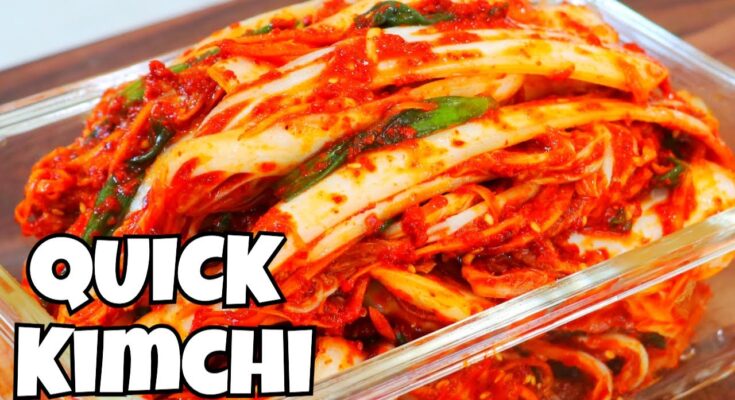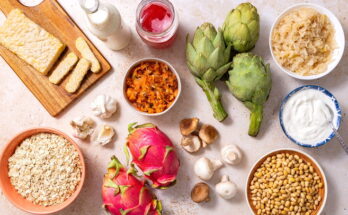Kimchi Recipe: Kimchi, the iconic Korean side dish, is a delicious and nutrient-packed staple made primarily from fermented vegetables, especially cabbage and radish. Traditionally spiced and seasoned with garlic, ginger, and Korean chili flakes (gochugaru), kimchi combines sour, spicy, and umami flavors for a vibrant culinary experience. Originating from Korea centuries ago, this dish has gained worldwide popularity for its bold taste and numerous health benefits.
Not only is kimchi delicious, but it’s also incredibly nutritious. It’s rich in vitamins A, B, and C and loaded with probiotics due to the fermentation process, which supports gut health and digestion. Let’s explore the types of kimchi, the ingredients you’ll need, and how to make it in a step-by-step guide!
Types of Kimchi
Popular Varieties
The most commonly enjoyed kimchi is baechu kimchi, made from napa cabbage. However, Korean cuisine features over 200 varieties, including kkakdugi (cubed radish kimchi), pa kimchi (green onion kimchi), and chonggak kimchi (young radish kimchi). Each type has a unique taste, texture, and spice level, catering to different preferences.
Difference Between Fresh and Aged Kimchi
Kimchi can be enjoyed fresh, where the flavors are lighter, or aged, which has a more intense, sour taste. Fresh kimchi offers a crisp texture and subtle spiciness, while aged kimchi brings a deeper, tangier flavor profile, perfect for adding to dishes like stews and pancakes.
Selecting the Right Type for Your Taste
Newcomers to kimchi may prefer starting with fresh baechu kimchi or mild radish versions. More adventurous eaters might appreciate the stronger flavors of aged cabbage or spicy green onion kimchi. Experimenting with different types will help you find your favorite.
Ingredients for Traditional Kimchi
Essential Ingredients for Kimchi
Here’s what you’ll need to make a basic, authentic kimchi:
- 1 large napa cabbage
- ¼ cup sea salt (non-iodized)
- 5-6 green onions, chopped
- 1 medium daikon radish, julienned
- 1 small carrot, julienned
- 1 cup gochugaru (Korean chili flakes)
- 6 cloves garlic, minced
- 1-2 tablespoons grated ginger
- 3-4 tablespoons fish sauce or Korean salted shrimp
Optional Add-ins for Different Flavors
For additional flavors, you can add ingredients like apple or Asian pear for a hint of sweetness, or use soy sauce for a vegetarian twist. Some people also add a spoonful of sugar to balance the flavors.
Where to Find Authentic Kimchi Ingredients
Most ingredients for kimchi can be found at Asian grocery stores, particularly the Korean section. Gochugaru, Korean radishes, and fish sauce are key components of authentic kimchi, so it’s worth seeking these out for the best results.
Preparing Ingredients for Kimchi
Preparing the Cabbage: Cleaning and Cutting
Start by slicing the cabbage into halves or quarters, depending on your preference. Rinse each section thoroughly to remove any dirt. Cutting the cabbage allows the salt to penetrate, softening it and enhancing its flavor.
Salting the Cabbage: Importance and Technique
Salting the cabbage is a crucial step, as it draws out excess moisture and helps maintain the cabbage’s crisp texture during fermentation. Spread sea salt evenly between the cabbage leaves, focusing on the thicker stalks. Let it sit for 1-2 hours, occasionally turning to ensure all parts are salted.
Preparing Other Vegetables
Julienne the daikon radish and carrot and chop the green onions. These vegetables add crunch and color to the kimchi and help balance the flavor. Make sure they are evenly sized to ensure consistency in texture.
Making the Kimchi Paste
Garlic and Ginger: Flavor Foundations
Garlic and ginger are essential in kimchi paste, providing depth and a slightly spicy warmth. Mince or grate them finely to ensure they blend seamlessly with the cabbage and vegetables.
Gochugaru (Korean Chili Flakes): Choosing the Right Spice Level
Gochugaru is what gives kimchi its signature red hue and spicy kick. Adjust the amount based on your spice preference; one cup of gochugaru is common for a moderately spicy batch.
Creating the Fish Sauce Mixture
For a traditional kimchi paste, mix fish sauce with garlic, ginger, and gochugaru. The fish sauce introduces a savory, umami taste and supports the fermentation process. If you prefer a milder flavor, adjust the fish sauce quantity or try a vegetarian alternative, like soy sauce.
Step-by-Step Kimchi Recipe Guide
Step 1: Salting and Rinsing the Cabbage
Place the salted cabbage in a large bowl and let it sit for 1-2 hours. Once it’s tender, rinse the cabbage several times in cold water to remove excess salt. Gently squeeze out any remaining water.
Step 2: Creating the Kimchi Paste
Combine garlic, ginger, gochugaru, and fish sauce in a bowl to form a thick paste. Adjust seasoning as needed. The mixture should be pungent and spicy but balanced, complementing the fresh vegetables.
Step 3: Mixing the Vegetables and Paste
Coat the cabbage and other vegetables with the kimchi paste, massaging it into each leaf and ensuring all vegetables are covered. The paste should evenly coat everything, infusing it with flavor and color.
Step 4: Packing the Kimchi for Fermentation
Pack the coated cabbage tightly into a clean jar or container, pressing down to remove air bubbles. Leave about an inch of space at the top, as kimchi will expand slightly during fermentation. Seal the container loosely to allow gases to escape.
Tips for Perfect Fermentation
Choosing the Right Temperature and Time
Kimchi ferments best at a cool room temperature, around 60-70°F (15-21°C). At this temperature, ferment the kimchi for 1-2 days. For a longer fermentation, transfer it to the fridge after the initial period, where it will continue to develop slowly.
Recognizing Proper Fermentation
Bubbling, a slightly sour aroma, and a tangy taste indicate good fermentation. Taste the kimchi every day to check its progress and refrigerate it once it reaches your desired flavor.
Avoiding Common Mistakes in Fermenting Kimchi
Ensure the cabbage is properly salted and free from excess water before adding paste. Too much liquid can lead to soggy kimchi, while an airtight seal may prevent necessary fermentation gases from escaping.
Storing and Serving Kimchi
How to Store Kimchi Properly
Once the kimchi has fermented to your liking, store it in the refrigerator. It will keep for weeks to months, becoming tangier over time.
Serving Kimchi at Different Fermentation Stages
Fresh kimchi, with its crisp texture, can be eaten as is. Aged kimchi works well in stews and other dishes that benefit from a robust flavor.
Creative Ways to Use Kimchi in Cooking
Kimchi isn’t just a side dish! Use it to flavor fried rice, stir-fries, soups, and even add it to tacos for a fusion twist. Its versatility makes it a fantastic ingredient in countless recipes.
Adjusting Kimchi for Personal Preferences
Making Mild or Spicy Kimchi
Adjust the amount of gochugaru in your paste based on your spice tolerance. You can even add less or skip gochugaru for a milder, kid-friendly version.
Adjusting Salinity and Sourness
If your kimchi tastes too salty, reduce the salt amount in the brine. For less sourness, refrigerate earlier, slowing down the fermentation process.
Experimenting with Unique Ingredients
Add pear, apple, or even citrus zest to bring unique flavors to your kimchi. Experimenting with different ingredients can yield delightful, one-of-a-kind results.
Benefits of Homemade Kimchi
Nutritional Advantages of Homemade Kimchi
Homemade kimchi has no preservatives, providing a purer, probiotic-rich version of the dish. You control the ingredients, enhancing the dish’s health benefits and freshness.
Taste and Texture Comparison: Store-bought vs. Homemade
Homemade kimchi is usually fresher, crispier, and has a bolder flavor compared to store-bought varieties, which often have added preservatives.
Cost-effectiveness of Making Kimchi at Home
Buying ingredients in bulk and making kimchi at home can be more economical than purchasing pre-made jars, especially if you’re a frequent kimchi eater.
Common Kimchi Variations
Baechu Kimchi (Cabbage Kimchi)
This classic, spicy version is the most well-known and widely enjoyed, using napa cabbage as the main ingredient.
Kkakdugi (Radish Kimchi)
Made with cubed daikon radish, kkakdugi is crunchy and slightly milder, with a satisfying bite and a unique flavor profile.
Other Popular Kimchi Types to Try
Some popular varieties include oi-sobagi (cucumber kimchi) and dongchimi (water-based kimchi). Each offers a different texture and taste, catering to all types of palates.
Troubleshooting Common Kimchi Issues
Cabbage Too Soft or Too Salty
If your cabbage feels overly soft, try salting it for a shorter time. If it’s too salty, rinse it well before adding the kimchi paste.
Kimchi Has Unpleasant Smell or Taste
This can occur if kimchi is stored too long at room temperature. Proper refrigeration is key to maintaining freshness.
Ensuring Proper Fermentation
For consistent results, use a container that allows gases to escape, check temperatures regularly, and monitor your kimchi’s development to catch any issues early.
FAQs about Kimchi Recipe
What is Kimchi?
Kimchi is a traditional Korean side dish made from fermented vegetables, most commonly napa cabbage and Korean radishes, seasoned with chili pepper, garlic, ginger, and other spices.
How long does it take to ferment Kimchi?
The fermentation time for Kimchi varies depending on temperature and personal preference. At room temperature, it can take 1-2 days to begin fermenting. For a deeper, tangier flavor, store it in the refrigerator for 1-4 weeks.
Is Kimchi healthy?
Yes, Kimchi is rich in probiotics, vitamins, and antioxidants, which can support digestive health and boost the immune system. However, it’s best to consume in moderation due to its high salt content.
How should I store Kimchi?
Store Kimchi in an airtight container in the refrigerator to maintain its flavor and prevent spoilage. Properly stored, it can last for several months, intensifying in flavor over time.
What are some popular ways to use Kimchi?
Kimchi is versatile and can be enjoyed as a side dish, in fried rice, soups, stews, or even on top of tacos for a unique twist.
Conclusion
Making kimchi at home is a rewarding process that brings an iconic Korean dish into your kitchen. With this step-by-step guide, you’ll be able to create a delicious, nutritious kimchi to enjoy with family and friends. Whether you’re a kimchi beginner or a seasoned pro, this versatile dish has something for everyone.



